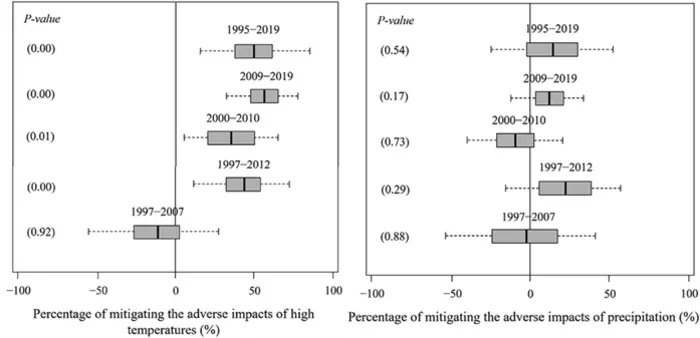
Amid the escalating threats posed by climate change, the stability and sustainability of China’s grain production have come under unprecedented pressure. Recent research led by experts Liu Dong, Feng Xiaolong, and Si Wei, published in the esteemed China Economic Quarterly International, sheds light on the complex interplay between climate variables and adaptive agricultural responses in China. By leveraging extensive rural observation data combined with advanced econometric modeling, the team has quantified the scope and mechanisms of adaptation that grain production exhibits in the face of rising temperatures and shifting precipitation patterns.
Their study reveals that adaptive behaviors by farmers and agricultural stakeholders have mitigated a significant proportion of the detrimental effects associated with higher temperatures. Through meticulous analysis, it was found that between 52.5% and 63.5% of the negative consequences of temperature increases on yield have been counteracted by adaptation strategies, especially in the cultivation of rice and maize. Wheat, however, remains less resilient, underscoring the crop-specific nuances in thermal stress tolerance. These findings highlight the differentiated physiological and agronomic properties among staple crops that mediate their response capacities to thermal anomalies.
The research harnesses a two-way fixed-effects econometric framework alongside the long-differences method, allowing for the systematic control of unobserved heterogeneity across regions and time. This method enhances the reliability of observed adaptation effects by accounting for confounding variables that could bias results in simpler models. By analyzing data from nationally representative rural fixed observation points, the authors provide a granular understanding of how climate adaptation manifests across China’s vast agro-ecological zones.
.adsslot_E8P0iU4bCV{width:728px !important;height:90px !important;}
@media(max-width:1199px){ .adsslot_E8P0iU4bCV{width:468px !important;height:60px !important;}
}
@media(max-width:767px){ .adsslot_E8P0iU4bCV{width:320px !important;height:50px !important;}
}
ADVERTISEMENT
Spatial heterogeneity emerges as a crucial factor in the study, demonstrating that northern grain-producing areas exhibit higher adaptive capacities to elevated temperatures compared to southern counterparts. This regional disparity is multifaceted. Northern regions, historically exposed to cooler climates, may have adopted technological innovations and crop management practices more vigorously in response to recent warming trends. Conversely, although southern regions face comparatively mild temperature increases, their limited adaptive development could render them vulnerable in the event of future extreme heat waves or prolonged thermal stresses.
Conversely, the study assesses the impact of excessive precipitation – another hallmark of climate variability poised to disrupt agricultural productivity. Unlike temperature-related stresses, adaptation strategies to mitigate the effects of intense rainfall events appear insufficient. The researchers caution that overabundant rainfall, often resulting in waterlogging and soil degradation, continues to compromise grain yield stability. The inability of current adaptive responses to fully address precipitation anomalies calls for a reassessment of agronomic practices and infrastructure resilience.
Key mechanisms underpinning adaptation include technological progress, the adoption of conservation tillage, and input adjustments tailored by local farming households. Technological advances alone can reduce the adverse effects of heat stress on grain output by nearly one-third. Conservation tillage, a practice that minimizes soil disturbance and enhances moisture retention, proves particularly effective for wheat and maize, bolstering their resistance to heat extremes. These mechanisms collectively underscore the potential of integrating agronomic innovations with localized adaptive management to sustain crop productivity.
In their analysis, Liu, Feng, and Si emphasize the critical role of micro-level decisions taken by farming households. Adaptation is not monolithic but rather manifests in diverse strategies reflecting environmental conditions, available technologies, and socio-economic incentives. The adoption of new cultivation techniques, improved seed varieties, and optimized water management collectively shapes the resilience landscape. Understanding these bottom-up adaptive responses is vital for crafting scalable policies that reflect on-the-ground realities.
The researchers further illustrate that infrastructure and resource management are fundamental pillars of effective adaptation. Enhancing drainage systems, building resilient irrigation networks, and improving water conservation measures are imperative to counteract the adverse effects of aberrant precipitation. These infrastructural investments must be coupled with scientific advances and farmer education to create a robust defense system against climatic perturbations.
From a policy perspective, this study highlights the urgent necessity to incorporate differentiated crop and regional vulnerabilities into national climate adaptation frameworks. While temperature impacts and their mitigations have received considerable attention, the limited response capacity to excessive rainfall demands heightened recognition and resource allocation. Enhancing the adaptability of grain production to multifaceted climate shocks will be pivotal in safeguarding China’s food security amidst an uncertain climatic future.
The implications of this research extend beyond the immediate geographical focus, offering transferable insights for other nations grappling with similar climatic uncertainties. The integration of high-resolution observational data with econometric evaluations presents a replicable model for assessing agricultural resilience globally. Furthermore, promoting adaptive agriculture aligned with local conditions can bridge the gap between scientific understanding and practical implementation.
The authors also acknowledge the need for future studies to explore the socio-economic dimensions influencing adaptation strategies, including policy incentives, market structures, and farmer knowledge dissemination. A comprehensive adaptation framework will encompass these variables, ensuring that scientific advancements translate into tangible gains for rural communities.
Ultimately, this study contributes a critical empirical baseline for stakeholders across scientific, governmental, and agricultural sectors. It offers both a warning regarding the continued challenges posed by excessive precipitation and a beacon of optimism about the successes achievable through well-designed adaptive interventions. Building resilience in grain production is not only vital for China’s food sovereignty but also a cornerstone in broader global efforts to confront climate change impacts on agriculture.
Subject of Research: People
Article Title: The Adaptation Level and Mechanism of Grain Production to Climate Change in China
Web References:
https://www.sciencedirect.com/science/article/pii/S2666933125000139
https://www.keaipublishing.com/en/journals/china-economic-quarterly-international/
References:
Liu, D., Feng, X., Si, W. (2025). The Adaptation Level and Mechanism of Grain Production to Climate Change in China. China Economic Quarterly International, DOI: 10.1016/j.ceqi.2025.03.001.
Image Credits: Liu, D., Feng, X., Si, W.
Keywords: Fertilizers, Pest control, Climate change
Tags: adaptive strategies in farmingagricultural stakeholders’ roles in adaptationChina’s grain production resilienceclimate change adaptation in agriculturecrop-specific responses to climateeconometric modeling in agricultureimpact of temperature on crop yieldsimplications of shifting precipitation patternsrice and maize adaptation techniquesrural observation data in agriculturesustainability in grain productionwheat thermal stress tolerance





